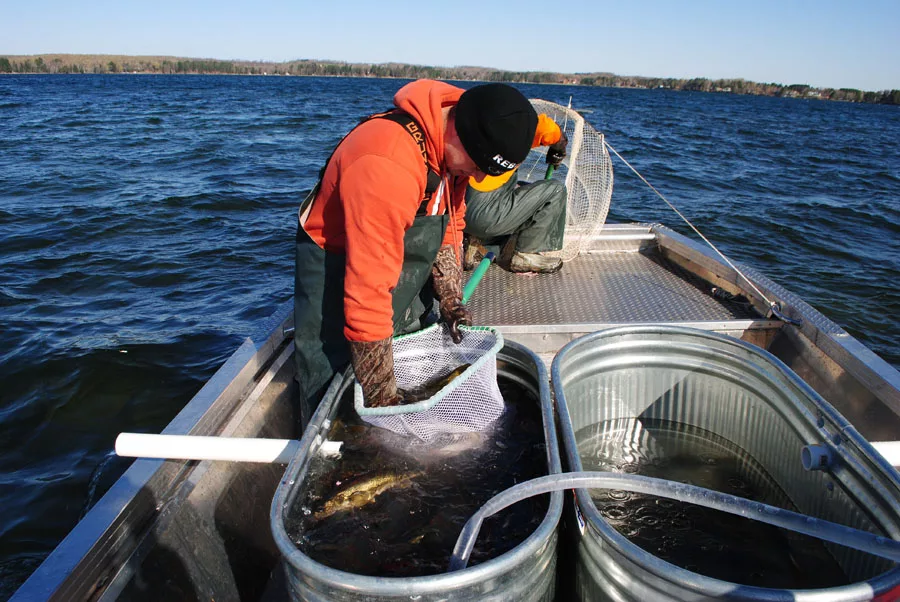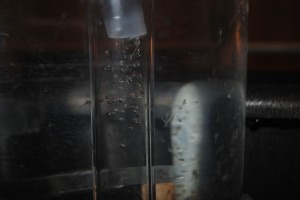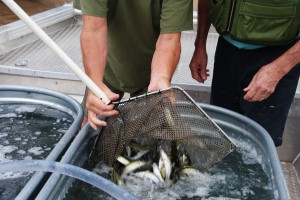
Sokaogon Chippewa Community receives grant to boost walleye stocking
Lynn Weide
Staff writer for the Forest Republican
Originally published in the Spring 2014 Wild Rivers Guide
The Sokaogon Chippewa recently received a grant for $298,900 through the DNR’s Walleye Initiative to fund the construction of two new rearing ponds this summer, an expansion that is expected to eventually double the community’s production of large walleye fingerlings for stocking area lakes.
The Walleye Initiative granted funds to nine public and private fish hatcheries to increase production of 6- to 8-inch walleye fingerlings to stock Wisconsin lakes. The Initiative also allocated additional state funding to purchase more large fingerlings from fish-rearing facilities with the goal of greatly increasing total statewide large fingerling stocking to create more fishing opportunities for the public, according to the DNR.
Since 1997, the Sokaogon Chippewa community has operated an indoor hatchery for incubating small walleye fry, according to Michael Preul, the fisheries biologist and hatchery manager. A limited number of walleye fingerlings has been raised using natural ponds, but without control of aeration, vegetation and other factors, the production of small fry has remained the priority until now.
Whereas small fry can effectively stock some lakes—Lake Metonga has been successfully rehabilitated using these smaller fry—the walleye need to be bigger to survive in other lakes, said Preul.
With the construction of four 0.6-acre rearing ponds last year, the goal was to ramp up the production of large walleye fingerlings, fed weekly with minnows. The four existing ponds have the ability to produce approximately 35,000 large fingerlings per year, said Preul.
The DNR grant is to be used to construct two new, one-acre rearing ponds and necessary infrastructure. Like the four existing ponds, the new ponds will feature rubber lining and an average depth of seven feet. Preul hopes to break ground on construction this summer and begin rearing fish in the new ponds in spring of 2015.
This year, Preul will raise a total of 20,000 larger fingerlings in the four existing ponds. With the addition of the two new ponds, the goal is to raise more than 50,000 large walleye fingerlings by 2017.
As in other years, fish of reproducing age will be collected from area lakes this spring with fyke nets. Preul and his team will work to collect spawn from the fish, mixing the eggs and the semen at the right time and allowing the spawn to incubate in the indoor hatchery for approximately 20 days. After the walleye fry mature, they will be transferred into the rearing ponds and raised to 6 to 7 inches before being released into local lakes in the fall.
According to Preul, walleye stocking serves as a short-term tool to boost natural walleye reproduction to enhance current fish populations and create new opportunities for anglers.
“The tribe is invested in (managing) walleye for the long-term,” said Preul. “All the work we’re doing is trying to do what Mother Nature does…it’s a win-win for everybody.”
As part of the initiative, several Forest County lakes, as well as lakes in Langlade, Oconto, Oneida, Vilas and Florence counties, will eventually be stocked on a rotational basis of 6 to 12 lakes per year.
In the future, the community hopes to build a larger incubation center with the capacity to work with different fish species, said Preul. For more information, contact Preul at 715-478-7621.


